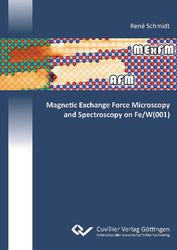| Fachbereiche | |
|---|---|
| Buchreihen (96) |
1378
|
| Nachhaltigkeit |
3
|
| Gesundheitswesen |
1
|
| Geisteswissenschaften |
2364
|
| Naturwissenschaften |
5406
|
| Mathematik | 229 |
| Informatik | 319 |
| Physik | 980 |
| Chemie | 1363 |
| Geowissenschaften | 131 |
| Humanmedizin | 243 |
| Zahn-, Mund- und Kieferheilkunde | 10 |
| Veterinärmedizin | 108 |
| Pharmazie | 147 |
| Biologie | 835 |
| Biochemie, Molekularbiologie, Gentechnologie | 121 |
| Biophysik | 25 |
| Ernährungs- und Haushaltswissenschaften | 45 |
| Land- und Agrarwissenschaften | 1004 |
| Forstwissenschaften | 201 |
| Gartenbauwissenschaft | 20 |
| Umweltforschung, Ökologie und Landespflege | 148 |
| Ingenieurwissenschaften |
1793
|
| Allgemein |
98
|
|
Leitlinien Unfallchirurgie
5. Auflage bestellen |
|
Erweiterte Suche
Magnetic Exchange Force Microscopy and Spectroscopy on Fe/W(001)
René Schmidt (Autor)Vorschau
Inhaltsverzeichnis, Datei (51 KB)
Leseprobe, Datei (80 KB)
In this work scanning probe techniques, namely frequency-modulated atomic force microscopy (FM-AFM) in the non-contact regime and related methods like Kelvin probe force microscopy (KPFM), magnetic force microscopy (MFM), and magnetic exchange force microscopy (MExFM), are utilized in ultra high vacuum and at low temperatures to structurally, electronically and magnetically study the monolayer regime of iron on tungsten (001) in real space. Implementing the spectroscopic mode of MExFM, that is, magnetic exchange force spectroscopy (MExFS), the exchange interaction between single iron atoms with antiparallel coupling is experimentally accessed for the first time.
Iron grows pseudomorphically on W(001) whereby the layers are highly strained. Differences in strain between first and second layer iron and hybridization with the substrate lead to differences in electronic properties and magnetism: both layers exhibit a different work function, mapped with KPFM. Interestingly, even on the same layer, different work functions are observed. Moreover, both layers are magnetically different. The second layer is ferromagnetic (FM) with in-plane anisotropy as verified by MFM, while the first layer is antiferromagnetic (AF) with out-of-plane anisotropy. Using MexFM the AF alignment of the monolayer magnetic moments is resolved by detecting the short-ranged magnetic exchange force between tip and sample. The origin of the magnetic contrast formation is discussed and compared to ab initio calculations. Later, MExFS, which allows to directly measure the distance dependence of the magnetic exchange interaction between an atomically sharp magnetic tip and the antiferromagnetically ordered Fe monolayer on W(001), is employed. The site specific distance dependence of the total tip-sample interaction is recorded above Fe atoms which exhibit parallel as well as antiparallel atomic magnetic moments. The contribution of the magnetic exchange interaction between both sites can be extracted by subtracting the two curves from each other. All other interactions are identical on both sites. The experimental results are compared to ab initio calculations accounting for magnetically different tips composed of either Cr or Fe, or mixtures of both. Depending on symmetry and stability of the experimentally used probe tips, qualitatively different MExFM contrasts and MExFS data with a stronger distance dependence are observed. By analyzing the energy loss per single cantilever oscillation cycle, simultaneously recorded with topography and frequency shift in the experiments, a bottom-up characterization of the structurally and magnetically unknown probe tip apex is given. Considering the tip apex as magnetically and structurally independent cluster allows to explain the observed tip behavior.
| ISBN-13 (Printausgabe) | 3869558555 |
| ISBN-13 (Printausgabe) | 9783869558554 |
| ISBN-13 (E-Book) | 9783736938557 |
| Sprache | Englisch |
| Seitenanzahl | 144 |
| Auflage | 1 Aufl. |
| Band | 0 |
| Erscheinungsort | Göttingen |
| Promotionsort | Universität Hamburg |
| Erscheinungsdatum | 17.08.2011 |
| Allgemeine Einordnung | Dissertation |
| Fachbereiche |
Physik
|








